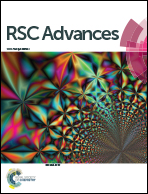Determination of blood potassium using a fouling-resistant PVDF–HFP-based optode†
Abstract
Monitoring potassium levels in blood is a significant aspect of clinical analysis. For this reason, polymeric bulk optodes have received much attention for their use in portable and easy-to-use analysis systems in situ determination without additional calibration. However, blood contamination on the detection area of the sensor can hinder accurate sensing and also increases risk of infection from the wounds. In this paper, we report a system for determination of potassium in blood which has the additional advantage of being blood-fouling resistant. We have replaced the generally used poly(vinyl chloride) (PVC) with hydrophobic fluorinated poly(vinylidene fluoride–hexafluoropropylene) (PVDF–HFP) for preparation of a polymeric bulk optode. Sensing ability in the visual range of the polymeric bulk optode was retained despite the variation of the polymer matrix. These polymeric bulk optodes are suitable for potassium determination in blood with the PVDF–HFP-based optode possessing better blood antifouling properties than the PVC-based optode. The blood monitoring system described here represents the basis for functionalization of the optode toward safe and easily implementation in blood and in situ sensing applications.


 Please wait while we load your content...
Please wait while we load your content...